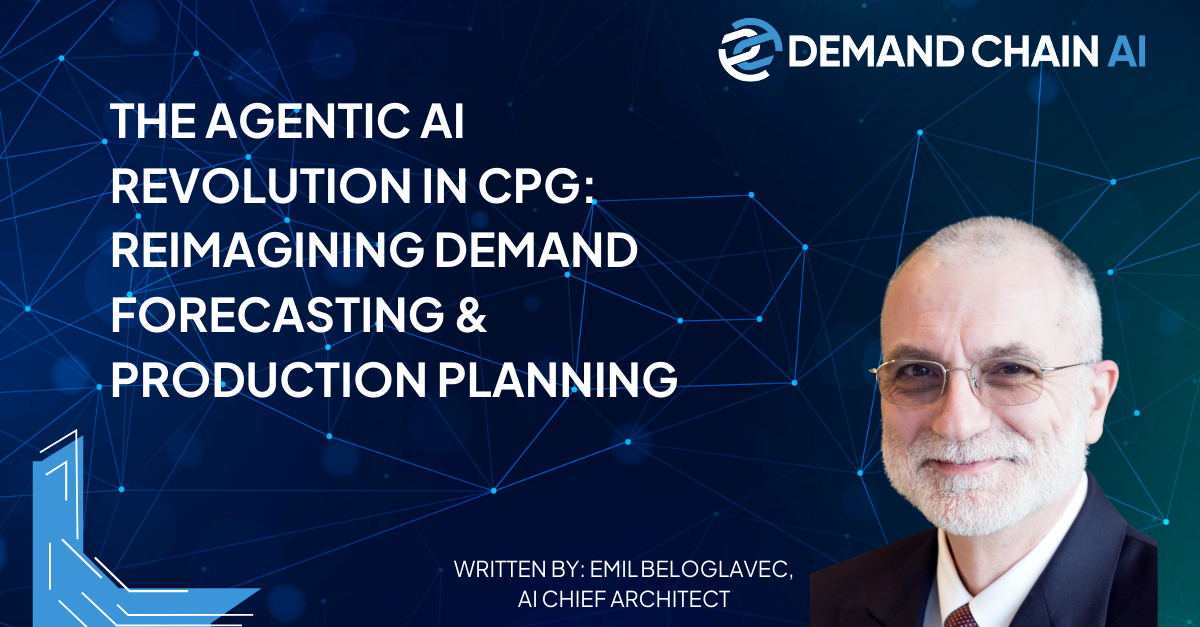
By Emil Beloglavec, AI Chief Architect, Demand Chain AI
Why it matters:
Consumer Packaged Goods (CPG) companies operate on tight margins and volatile demand. Generative AI (GenAI) is not just another tech trend—it’s redefining how businesses sense, respond to and shape demand, turning forecasting and planning into dynamic, intelligent systems.

What’s changing: From rigid to responsive
Traditional demand forecasting and production planning rely on historical data, batch processes and limited scenario analysis. They’re reactive and siloed.
GenAI shifts this paradigm—creating agentic systems that are:
- Autonomous in decision-making
- Proactive in identifying and responding to risks and opportunities
- Conversational for intuitive human interaction
- Context-aware and continuously learning

Source: Nvidia, Citi Global Insights
Forecasting gets an upgrade: Dynamic, continuous, precise
Old way: Forecasts updated monthly or quarterly, driven by lagging indicators and static models.
New way with GenAI:
- Multimodal data ingestion - Pulls real-time inputs from POS data, social sentiment, weather, promotions, competitor pricing and macroeconomic signals.
- Auto-segmentation & clustering - Identifies demand patterns at SKU/store/channel levels without human-defined rules.
- Scenario generation on the fly - Explores “what-if” conditions interactively—e.g., “What happens if Walmart drops prices next week?”
- Human-in-the-loop fine-tuning - Demand planners collaborate with AI through natural language. No coding required. “Instead of static, top-down planning cycles, GenAI supports always-on demand sensing and forecasting.”
Production Planning: From constraint-based to cognition-driven
Traditional setup: Linear, rule-heavy planning engines constrained by pre-coded logic.
With GenAI:
- Constraint-aware generative planning - The system proposes feasible, optimized production schedules while considering labor, inventory, capacity and shelf-life.
- Rapid replanning - Disruptions (e.g., a supplier delay) trigger instant re-optimization across plants and SKUs.
- Conversational interfaces - Planners ask: “Can we shift production of Product X to Plant B next week?” The AI simulates outcomes in seconds.
- Integrated digital twin - A virtual replica of supply chain dynamics lets AI test and learn continuously, surfacing unexpected bottlenecks or opportunities.
Why GenAI beats traditional AI/ML in CPG ops
- Agentic reasoning > statistical prediction - GenAI reasons across multiple scenarios and goals. Not just extrapolating trends—it’s designing plans.
- Interactivity - Decision-makers aren’t just consumers of insights—they co-create outcomes with AI, conversationally.
- Speed + scale – GenAI agents work 24/7 across SKUs, channels, geographies, and tiers of the supply chain—at speed no team can match.
Real-world use cases driving value
- Promotional lift forecasting – A GenAI agent simulates sales impact of a proposed promotion using historical lift, cross-product cannibalization, and competitor behavior.
- Production reprioritization - When raw materials run short, GenAI agents suggest optimal production reallocation—factoring in profit, penalties, and forecast risk.
- Retailer-specific demand shaping – Different strategies (e.g., price drops, packaging tweaks) are tested virtually before execution—maximizing ROI.
Results that matter
Companies deploying GenAI in demand and production planning are seeing:
- 20–30% forecast error reduction
- 10–20% inventory efficiency gains
- 15% better asset utilization
- Millions saved from waste reduction and overproduction
Barriers to adoption (and how to break them)
- Siloed data systems - Start by centralizing demand, supply, and external data into a unified platform.
- Legacy tech stack - GenAI can sit atop existing planning systems—no need to rip and replace.
- Change resistance - Position GenAI agents as copilots, not replacements. Build trust through transparency and small wins.
Bottom line
GenAI is not just enhancing the CPG demand and production cycle—it’s reinventing it.
Executives who embrace these intelligent, adaptive systems will turn forecasting from a guessing game into a strategic edge—and win the shelf space war before it even starts.
CTA
Invest in talent + tools - Equip your data scientists and planners with GenAI-enablement platforms.
Prioritize explainability - Ensure GenAI recommendations are transparent—critical for business adoption.
Think in systems - Adopt a flywheel mindset: Each interaction improves the agent, making the system smarter over time.
Demand Chain AI is working hard to deliver the optimal solutions for each business case our CPG clients are facing. Contact us HERE to find out how we can help you.

